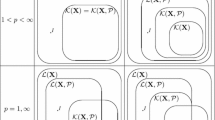Abstract
We introduce modulation type spaces associated with the generators of polynomially bounded groups. Besides strongly continuous groups we study in detail the case of bi-continuous groups, e.g. weak\(^*\)-continuous groups in dual spaces. It turns out that this gives new insight in situations where generators are not densely defined. Classical modulation spaces are covered as a special case but the abstract formulation gives more flexibility. We illustrate this with an application to a nonlinear Schrödinger equation.
Similar content being viewed by others
References
Bényi, A., Gröchenig, K., Okoudjou, K.A., Rogers, L.G.: Unimodular Fourier multipliers for modulation spaces. J. Funct. Anal. 246(2), 366–384 (2007)
Bényi, A., Okoudjou, K.A.: Local well-posedness of nonlinear dispersive equations on modulation spaces. Bull. Lond. Math. Soc. 41(3), 549–558 (2009)
Chaichenets, L., Hundertmark, D., Kunstmann, P., Pattakos, N.: Local well-posedness for the nonlinear Schrödinger equation in modulation space \(M_{p,q}^s ({\mathbb{R}}^d)\). arXiv:1610.08298
Feichtinger, H.G.: Modulation Spaces Over Locally Compact Abelian Groups. Technical report, University Vienna (1983)
Feichtinger, H.G.: Modulation spaces: looking back and ahead. Sampl. Theory Signal Imaging Process. 5(2), 109–140 (2006)
Feichtinger, H.G., Narimani, G.: Fourier multipliers of classical modulation spaces. Appl. Comput. Harmon. Anal. 21, 349–359 (2006)
Haase, M.: The Functional Calculus for Sectorial Operators, Operator Theory: Advances and Applications, vol. 169. Birkhäuser, Basel (2006)
Haase, M.: Abstract extensions of functional calculi. In: Zemánek, J., Tomilov, Y. (eds.) Études Opératorielles, vol. 112, pp. 153–170. Banach Center Publications, Institute of Mathematics, Polish Academy of Sciences, Warsaw (2017)
Haase, M.: Lectures on Functional Calculus, 21st International Internet Seminar (2018). https://www.math.uni-kiel.de/isem21/en/course/phase1/isem21-lectures-on-functional-calculus. Accessed 6 March 2019
Kühnemund, F.: A Hille-Yosida theorem for bi-continuous semigroups. Semigroup Forum 67(2), 205–255 (2003)
Kriegler, C.: Functional calculus and dilation for \(C_0\)-groups of polynomial growth. Semigroup Forum 84, 393–433 (2012)
Kriegler, C., Weis, L.: Spectral multiplier theorems and averaged \(R\)-boundedness. Semigroup Forum 94, 260–296 (2017)
Wang, B., Hudzik, H.: The global Cauchy problem for the NLS and NLKG with small rough data. J. Differ. Equ. 232, 36–73 (2007)
Author information
Authors and Affiliations
Corresponding author
Additional information
Communicated by Abdelaziz Rhandi.
Publisher's Note
Springer Nature remains neutral with regard to jurisdictional claims in published maps and institutional affiliations.
The author acknowledges support by the DFG through CRC 1173.
Appendix A. Two auxiliary results
Appendix A. Two auxiliary results
Here we provide proofs for a well-known result on the short time Fourier transform and for the contruction of \(\tau _X\)-Riemann type integrals with respect to measures \(\mu \in {\mathscr {M}}({\mathbb {R}})\).
Fix \(g\in {\mathscr {S}}({\mathbb {R}}){\setminus }\{0\}\). The short-time Fourier transform with window g of \(f\in {\mathscr {S}}'({\mathbb {R}})\) is the function \(V_gf:{\mathbb {R}}\times {\mathbb {R}}\rightarrow {\mathbb {C}}\) defined by
where the duality bracket extends the usual scalar product in \(L^2({\mathbb {R}})\). We shall only need that \(V_g\) maps \({\mathscr {S}}({\mathbb {R}})\) to rapidly decreasing functions.
Lemma A.1
For \(g\in {\mathscr {S}}({\mathbb {R}}){\setminus }\{0\}\) and \(f\in {\mathscr {S}}({\mathbb {R}})\) the function
is bounded on \({\mathbb {R}}\times {\mathbb {R}}\) for all \(k,l>0\).
This is well-known but we reprove it here for convenience.
Proof
We have
where \(\sigma g(y)=g(-y)\). By \(f,g\in {\mathscr {S}}({\mathbb {R}})\) we infer that \(\langle x \rangle ^k V_gf(x,\xi )\) is bounded for any \(k>0\). For any \(l\in {\mathbb {N}}\) we use integration by parts to obtain
Since \({\mathscr {S}}({\mathbb {R}})\) is invariant under taking derivatives we can combine both arguments to obtain the assertion.\(\square \)
For the following result on \(\tau _X\)-Riemann type integrals we suppose that Assumption 4.1 holds.
Proposition A.2
Let \(f:[a,b]\rightarrow X\) be a \(\tau _X\)-continuous and norm-bounded function and let \(\mu \in {\mathscr {M}}({\mathbb {R}})\) be a complex Borel measure. For any partition \(a=t_0<t_1<\ldots <t_n=b\) and any vector \((\xi _1,\ldots ,\xi _n)\) with \(\xi _j\in [t_{j-1},t_j)\) we define the Riemann type sum
Then the \(\tau _X\)-limit of \(S(f,t_j,\xi _j)\) exists in X as \(\max _j|t_j-t_{j-1}|\) tends to 0. This limit is denoted \(\int _{[a,b]} f(t)\,d\mu (t)\). We have the estimate
and for any \(\tau _X\)-continuous seminorm p we have
Proof
If \(\Vert f(t)\Vert _{X}\le C\) we easily get
By Assumption 4.1 (i) it thus suffices to show the Cauchy property. So we let \(\delta >0\) and take two partitions \((t_j)\) and \((s_k)\) such that \(\max _j|t_j-t_{j-1}|\) and \(\max _k|s_k-s_{k-1}|\) are \(\le \delta \) and we take two corresponding vectors \((\xi _j)\) and \((\eta _k)\). Then we rewrite
where \((u_l)\) is a partition obtained by the union of the \(t_j\) and the \(s_k\) and we have \(\{\widetilde{\xi }_l\}=\{\xi _j\}\), \(\{\widetilde{\eta }_l\}=\{\eta _k\}\) as sets, but we have to repeat \(\xi _j\) according to the splitting of the interval \([t_{j-1},t_j)\). Then not necessarily \(\widetilde{\xi }_l\in [u_{l-1},u_l)\) but we have at least \(|\widetilde{\xi }_l-u_l|\le \delta \) and \(|\widetilde{\xi }_l-u_{l-1}|\le \delta \). The same holds for the \(\widetilde{\eta }_l\) so that \(|\widetilde{\xi }_l-\widetilde{\eta }_l|\le 2\delta \). Taking a \(\tau _X\)-continuous seminorm p we thus have
The assertion thus follows from uniform \(\tau _X\)-continuity of f on [a, b]. The p-estimates are immediate, for the norm estimate we use Assumption 4.1 (iii) and the p-estimates for \(p:=|\left\langle \cdot ,\psi \right\rangle |\) where \(\psi \in \Phi (\tau _X)\). \(\square \)
Rights and permissions
About this article
Cite this article
Kunstmann, P.C. Modulation type spaces for generators of polynomially bounded groups and Schrödinger equations. Semigroup Forum 98, 645–668 (2019). https://doi.org/10.1007/s00233-019-10016-1
Received:
Accepted:
Published:
Issue Date:
DOI: https://doi.org/10.1007/s00233-019-10016-1




